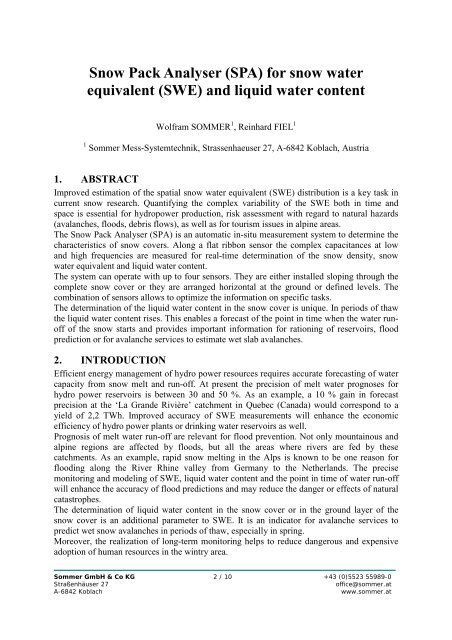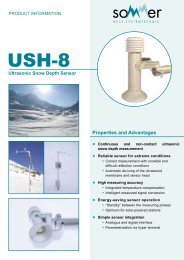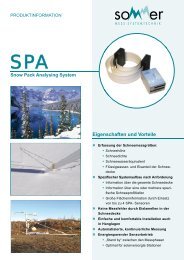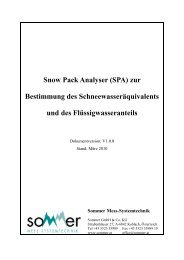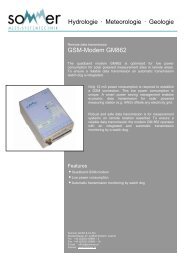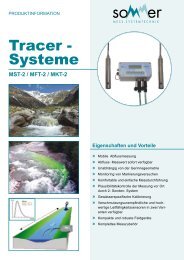for snow water equivalent - Sommer Mess-Systemtechnik
for snow water equivalent - Sommer Mess-Systemtechnik
for snow water equivalent - Sommer Mess-Systemtechnik
You also want an ePaper? Increase the reach of your titles
YUMPU automatically turns print PDFs into web optimized ePapers that Google loves.
Snow Pack Analyser (SPA) <strong>for</strong> <strong>snow</strong> <strong>water</strong><br />
<strong>equivalent</strong> (SWE) and liquid <strong>water</strong> content<br />
<strong>Sommer</strong> GmbH & Co KG<br />
Straßenhäuser 27<br />
A-6842 Koblach<br />
Wolfram SOMMER 1 , Reinhard FIEL 1<br />
1 <strong>Sommer</strong> <strong>Mess</strong>-<strong>Systemtechnik</strong>, Strassenhaeuser 27, A-6842 Koblach, Austria<br />
1. ABSTRACT<br />
Improved estimation of the spatial <strong>snow</strong> <strong>water</strong> <strong>equivalent</strong> (SWE) distribution is a key task in<br />
current <strong>snow</strong> research. Quantifying the complex variability of the SWE both in time and<br />
space is essential <strong>for</strong> hydropower production, risk assessment with regard to natural hazards<br />
(avalanches, floods, debris flows), as well as <strong>for</strong> tourism issues in alpine areas.<br />
The Snow Pack Analyser (SPA) is an automatic in-situ measurement system to determine the<br />
characteristics of <strong>snow</strong> covers. Along a flat ribbon sensor the complex capacitances at low<br />
and high frequencies are measured <strong>for</strong> real-time determination of the <strong>snow</strong> density, <strong>snow</strong><br />
<strong>water</strong> <strong>equivalent</strong> and liquid <strong>water</strong> content.<br />
The system can operate with up to four sensors. They are either installed sloping through the<br />
complete <strong>snow</strong> cover or they are arranged horizontal at the ground or defined levels. The<br />
combination of sensors allows to optimize the in<strong>for</strong>mation on specific tasks.<br />
The determination of the liquid <strong>water</strong> content in the <strong>snow</strong> cover is unique. In periods of thaw<br />
the liquid <strong>water</strong> content rises. This enables a <strong>for</strong>ecast of the point in time when the <strong>water</strong> runoff<br />
of the <strong>snow</strong> starts and provides important in<strong>for</strong>mation <strong>for</strong> rationing of reservoirs, flood<br />
prediction or <strong>for</strong> avalanche services to estimate wet slab avalanches.<br />
2. INTRODUCTION<br />
Efficient energy management of hydro power resources requires accurate <strong>for</strong>ecasting of <strong>water</strong><br />
capacity from <strong>snow</strong> melt and run-off. At present the precision of melt <strong>water</strong> prognoses <strong>for</strong><br />
hydro power reservoirs is between 30 and 50 %. As an example, a 10 % gain in <strong>for</strong>ecast<br />
precision at the ‘La Grande Rivière’ catchment in Quebec (Canada) would correspond to a<br />
yield of 2,2 TWh. Improved accuracy of SWE measurements will enhance the economic<br />
efficiency of hydro power plants or drinking <strong>water</strong> reservoirs as well.<br />
Prognosis of melt <strong>water</strong> run-off are relevant <strong>for</strong> flood prevention. Not only mountainous and<br />
alpine regions are affected by floods, but all the areas where rivers are fed by these<br />
catchments. As an example, rapid <strong>snow</strong> melting in the Alps is known to be one reason <strong>for</strong><br />
flooding along the River Rhine valley from Germany to the Netherlands. The precise<br />
monitoring and modeling of SWE, liquid <strong>water</strong> content and the point in time of <strong>water</strong> run-off<br />
will enhance the accuracy of flood predictions and may reduce the danger or effects of natural<br />
catastrophes.<br />
The determination of liquid <strong>water</strong> content in the <strong>snow</strong> cover or in the ground layer of the<br />
<strong>snow</strong> cover is an additional parameter to SWE. It is an indicator <strong>for</strong> avalanche services to<br />
predict wet <strong>snow</strong> avalanches in periods of thaw, especially in spring.<br />
Moreover, the realization of long-term monitoring helps to reduce dangerous and expensive<br />
adoption of human resources in the wintry area.<br />
2 / 10 +43 (0)5523 55989-0<br />
office@sommer.at<br />
www.sommer.at


